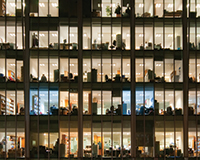 First there were cubicles, then there was open-plan, and then the argument about whether an office was even required. But could we be about to go full circle?
First there were cubicles, then there was open-plan, and then the argument about whether an office was even required. But could we be about to go full circle?
“Open-plan offices are the world’s biggest crime against productivity.”
When JLL’s managing director of strategic consulting makes a statement like that, it is worth paying attention.
And when three of the industry’s most pioneering tech entrepreneurs and strategists agree with her, then there is a danger you are already behind the curve.
This is exactly what happened at the British Council for Offices’ conference in Chicago last week. Peppered throughout the debates around macro-economics, where we are in the property cycle and the technology behind liveable cities, one topic kept rearing its head – a return to the meeting room.
And when JLL’s Bernice Boucher flew in from New York to make her bold statement, it became a debate in its own right.
But this demand for a return to the meeting room is not coming from the employees you would expect.
Swathes of young workers – the under-35s that have so often been considered the biggest advocates of buzzy, sociable, open-plan workplaces – are desperate for respite from their technology-filled lives, says Boucher.
Welcome to the world of digital detoxers.
Thimon De Jong, director of Whetston Strategic Foresight, a Dutch think-tank focusing on the impact of socio-economic and cultural changes on strategic decision making, provides some background.
“Young people are those who are most likely to seek out digital balance. They realise that technology overload is getting in the way of their work and their social lives,” he says.
“So while modern offices do still need more room for people to interact and to meet people they would not usually meet, there also a need for more rooms where people can work alone or in silence – individual rooms or pods.”
He adds: “There is also an increased demand from the younger generation for device-free meetings. No phones, no iPads, no computers. And so we could see the introduction of device-friendly and device-free meeting rooms soon.”
Howard Tullman, founder of 1871 – Chicago’s 50,000 sq ft hub for digital start-ups – agrees. He says that, apart from bigger mailrooms to accommodate an increase in online shopping, meeting rooms look set to be one of the biggest trends in modern office design.
“It might come as a surprise, but this is what people want,” he says. “They want to meet in person, to sit down and have a proper discussion, but they do not necessarily want to do it in noisy break-out areas any more. They want walls.”
The reaction from architects and developers to the suggestion that meeting rooms are becoming increasingly popular is mixed.
“It seems very back and forth. From meetings rooms and cubicles to open-plan and back again,” says Argent managing partner David Partridge.
How long this demand will last is anyone’s guess, which is why designing and developing flexibility into modern offices will remain key. As DTZ’s EMEA chief executive John Forrester says: “When it takes 10 years to deliver a building, how else can property keep up with occupiers who change monthly, if not weekly?”
Listen to an interview with Thimon De Jong on the Estates Gazette podcast >>










